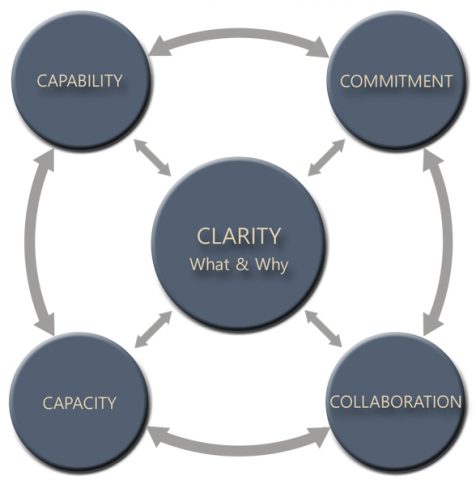If, like us, you are lucky enough to work with exceptional companies, you cannot help but look behind what makes them the success they are. And you discover that their success is not an accident but is rather down to obsessive execution underpinned with core disciplines.
From our research and observations, Thinking Focus has identified five traits you will find in all the most productive organisations. These guiding principles can be applied by any organisation to enable their people to be productive in the right way. They also form the basis of our 5Cs Results Model, which we use in our work with a range of forward-thinking organisations to help them accelerate business growth, embed change or transform culture.
-
Purpose and Clarity
The most productive organisations we’ve worked with regularly reinforce purpose and clarity within all their people. A clear and compelling purpose – the ‘why’ we do what we do, aligned to what we do – is consistently shared and communicated, so everyone has a common clarity of vision. This increases effectiveness as people work to their greatest level of contribution in order to help achieve the big picture.
Take note, though, not to confuse being efficient with being effective. We have worked in, and with, organisations where people were highly efficient and executed their tasks promptly and to a high standard. The problem was, they were not working on the right things!
As a leader aiming to help your people be as productive as possible, challenge yourself: Is it efficiency or effectiveness you’re after? You are likely to have efficient people, but do they understand why they are doing what they are doing? If not, revisit your purpose and get them focused on doing those things that will achieve that purpose.
In his book Good to Great, Jim Collins shares the importance of getting the right people on the bus and the wrong people off the bus, which sounds spot on to me. However, he goes on to say that those right people are the ones who buy into your purpose, not your plan. This means that if, as is often the case, the plan needs to change, those right people will remain committed to the vision and the higher purpose that drives everything you do.
-
Collaboration
In our work, although we shouldn’t be, we are always surprised by how much internal politics, assumptions and egos get in the way of productivity. The cultural environment is set up to be adversarial, which is not conducive to delivering the strategy. So many senior leaders will argue that they achieve the outcome they wanted, but we often wonder at what cost to their teams. What underlying damage has been caused and what is hidden from view that challenges the definition of productivity? Is the focus on the short-term nature of business and the need to deliver results or is it on the long-term performance of the company?
If I refer back to Jim Collins, he shares ‘level 5 leadership’. Level 5 leaders build with the next generation in mind, they are ambitious and focus on the success of the company ahead of themselves. The level 5 leader is obsessed with sustained results and will do whatever it takes to get to great.
In our experience, companies whose leaders collaborate more effectively achieve more significant results, and we have seen those indicators of level 5 leadership where the focus is always on the higher purpose.
-
Capability
When we talk about capability, most people think of training but it’s actually much more than that as Paul Matthews, author of Capability at Work, explains:
- Knowledge – do I (the worker) have the knowledge to do what is required?
- Skills – am I (the worker) able to apply myself to do what is required?
- Mindset – do I (the worker) believe I can do what is expected of me?
- Physiology – am I (the worker) able to do what is required physically?
- Environment – have we (the company) provided the right systems, processes, tools, management support and culture for our people to perform effectively?
In our experience, the organisations that develop more productive workforces and the ones who recognise that there is a need for a balanced assessment of capability. The inclusion of ‘environment’ in the list above is significant and its notable that the onus here is on the company. It is no surprise that the elements that make up the environment are key to engagement, and that the link between engagement and productivity is long since proven.
-
Capacity
The topic of bandwidth is a perennial one. Most teams will argue they are at full capacity whereas most leaders believe there is scope to do more. The reality probably lies somewhere between the two!
However, the most important thing here is to be clear about what we have on the agenda and why. Does the list pass the purpose test, will doing ‘it’ enable us to achieve the higher purpose? If not, it should not be on the list at all.
Warren Buffet invests much time deciding what makes this list and what doesn’t make his list. There is no ‘We will have a go if we get the time’ list or ‘Let’s spend a bit of time on it’ list. It either makes the list, or it doesn’t; there’s no half way house. Leaders are paid to make big decisions, to choose what strategy we should back and why. Indecision leads to a straddled strategy which is trying to be all things to everyone. In our experience, companies who have followed the mantra of ‘If we could only do one thing?’ are more productive and effective.
-
Commitment
Commitment is a set of tests or questions which should be asked on a regular basis. This provides a navigational check in the context of an organisation’s vision and strategy to see whether the current plan is going to hit the mark.
- Is our purpose clear, compelling, and understood by the business?
- Are we collaborating in the most effective way?
- Have we developed the capability of our people to achieve our goals?
- Are we choosing to focus our resources on the right things?
- Are we committed to this vision (are the right people on this bus)?
These questions all elicit a deliberate Yes/No answer, with those who adopt level 5 leadership using the ‘No’ answers as opportunities to fix it on their journey to greatness.
It is worth noting that level 5 leaders show humility and are more likely to be cautious in their evaluation, rather than deluded or over-confident.



